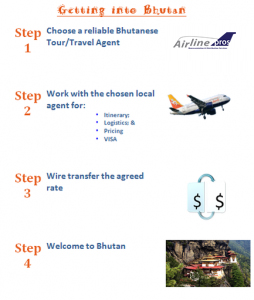Paro Taktsang also known as the Taktsang Palphug Monastery and the Tiger’s Nest), is a prominent Himalayan Buddhist sacred site and the temple complex is located in the cliffside of the upper Paro valley in Bhutan.
A temple complex was first built in 1692, around the Taktsang Senge Samdup cave where Guru Padmasambhava is said to have meditated for three years, three months, three weeks, three days and three hours in the 8th century. Padmasambhava is credited with introducing Buddhism to Bhutan and is the tutelary deity of the country. Today, Paro Taktsang is the best known of the thirteen taktsang or “tiger lair” caves in which he meditated.
The temple devoted to Padmasambhava (also known as Gu-ru mTshan-brgyad Lhakhang, “the Temple of the Guru with Eight Names”) is an elegant structure built around the cave in 1692 by Gyalse Tenzin Rabgye; and has become the cultural icon of Bhutan. A popular festival, known as the Tsechu, held in honor of Padmasambhava, is celebrated in the Paro valley sometime during March or April.
Backgrond and Legends
According to the legend related to this Taktsang (which in Tibetan language is spelt [clarification needed] (stag tshang) which literally means “Tiger’s lair”, it is believed that Padmasambhava (Guru Rinpoche) flew to this location from Tibet on the back of a tigress from Khenpajong. This place was consecrated to tame the Tiger demon.
Guru Padmasambhava founder of the meditations cave. Wall painting on Paro Bridge. An alternative legend holds that a former wife of an emperor, known as Yeshe Tsogyal, willingly became a disciple of Guru Rinpoche (Padmasambahva) in Tibet. She transformed herself into a tigress and carried the Guru on her back from Tibet to the present location of the Taktsang in Bhutan. In one of the caves here, the Guru then performed meditation and emerged in eight incarnated forms (manifestations) and the place became holy. Subsequently, the place came to be known as the “Tiger’s Nest”.
The popular legend of the Taktsang monastery is further embellished with the story of Tenzin Rabgye, who built the temple here in 1692. It has been mentioned by authors that the 8th century guru Padmasmabhava had reincarnated again in the form of Tenzin Rabgye. The corroborative proofs mooted are: that Tenzin Rabgye was seen (by his friends) concurrently inside and outside his cave; even a small quantity of food was adequate to feed all visitors; no one was injured during worship (in spite of the approach track to the monastery being dangerous and slippery); and the people of the Paro valley saw in the sky various animal forms and religious symbols including a shower of flowers that appeared and also vanished in the air without touching the earth.
Establishment as a meditation site
As noted before, the monastery was built around the Taktsang Senge Samdup (stag tshang seng ge bsam grub) cave, where custom holds that the Indian Guru Padmasambahva meditated in the 8th century. He flew to this place from Tibet on the back of Yeshe Tsogyal, whom he transformed into a flying tigress for the purpose and landed at the cliff, which he “anointed” as the place for building a monastery. He established Buddhism and the Nyingmapa school of Mahayana Buddhism in Bhutan, and has been considered the “protector saint of Bhutan”. Later, Padmasmbahva visited Bumthang district to subdue a powerful deity offended by a local king. Padmasambhava’s body imprint is stated to be imprinted on the wall of a cave near Kurje Lhakhang temple. In 853, Langchen Pelkyi Singye came to the cave to meditate and gave his name of Pelphug to the cave, “Pelkyi’s cave”.[5] After he died later in Nepal, his body was said to have been miraculously returned to the monastery by the grace of the deity Dorje Legpa; it is now said to be sealed in a chorten in a room to the left at the top of the entrance stairway.[5] The chorten was restored in 1982-83 and again in 2004.[5]
Milarepa (1040–1123), who meditated at the cave in Taktsang
From the 11th century, many Tibetan saints and eminent figures came to Taktsang to meditate, including Milarepa (1040–1123), Pha Dampa Sangye (died 1117), the Tibetan yogini Machig Labdrön (1055–1145) and Thangton Gyelpo (1385–1464).[5] In the latter part of the 12th century, the Lapa School was established in Paro.[6] Between 12th and 17th centuries, many Lamas who came from Tibet established their monasteries in Bhutan. The first sanctuary to be built in the area dates to the 14th century when Sonam Gyeltshen, a Nyingmapa lama of the Kathogpa branch came from Tibet.[5] The paintings he brought can still be faintly discerned on a rock above the principal building although there is no trace of the original one.[5] The Taktsang Ugyen Tsemo complex, which was rebuilt after a fire in 1958 is said to date back to 1408.[5] Taktsang remained under the authority of the Kathogpa lamas for centuries until the mid 17th century.


